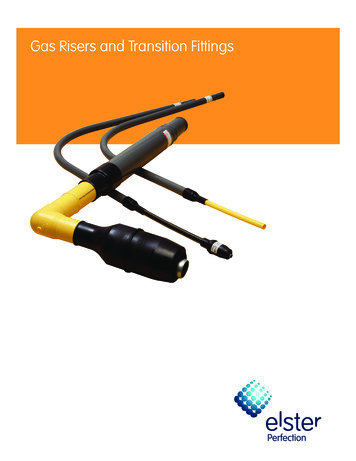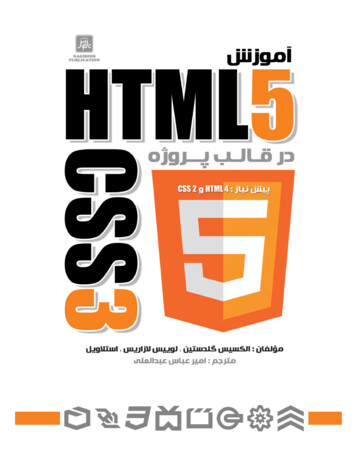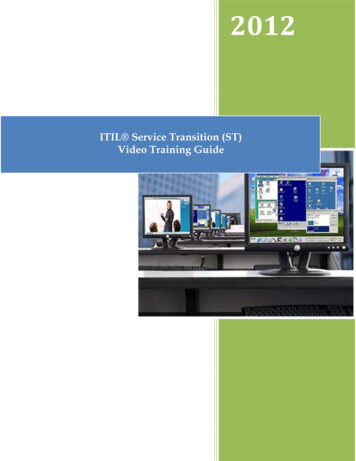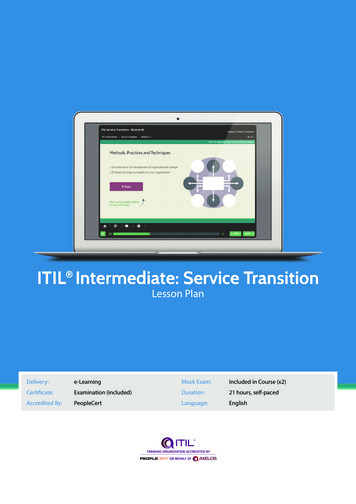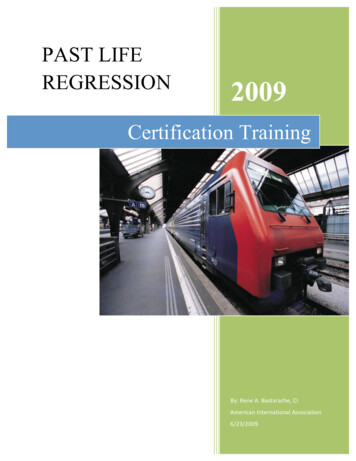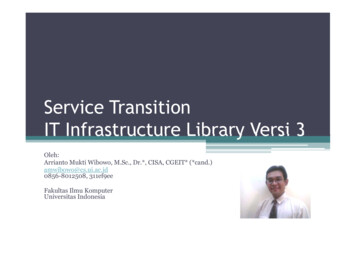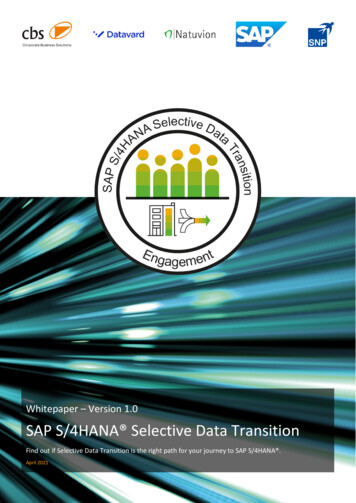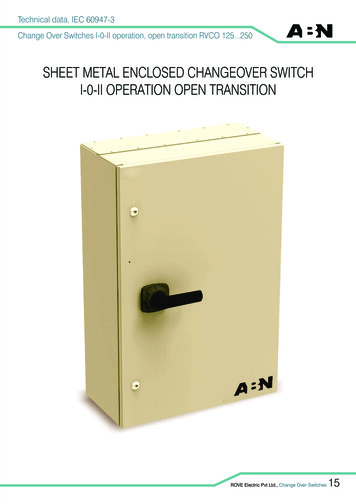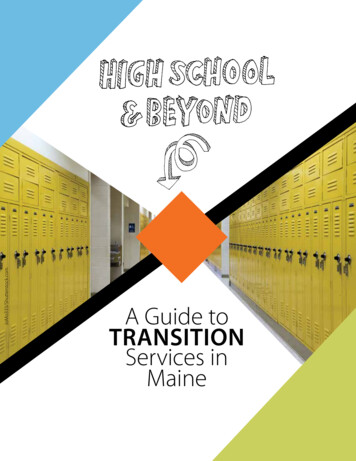
Transcription
JoMo333/Shutterstock.comA Guide toTRANSITIONServices inMaine
Department of Health and Human ServicesChild and Family Services2 Anthony Avenue11 State House StationAugusta, Maine 04333-0011Tel: (207) 624-7900; Fax: (207) 287-5282TTY Users: Dial 711 (Maine Relay)Dear Reader,Welcome! The Department of Health and Human Services is pleased to have partneredwith a variety of State of Maine agencies, private service providers, and valuedcommunity members to bring you A Guide to Transition Services in Maine.We wish to thank everyone who contributed their knowledge, time, and resources tomake this Guide possible.The Guide was developed with the assistance of youth and families to provide resourceand planning information to youth and young adults, their families, and their supports toaddress the many different areas of transition planning. It is my hope that you will findthis Guide helpful in supporting youth and young adults in their successful transition toadulthood.The transition to adulthood has many exciting opportunities and pathways. I hopeA Guide to Transition Services in Maine will provide you with valuable information,ideas, and resources to assist in the journey.Sincerely,James Martin, LMSWDirector, Office of Child and Family Services
sheff/Shutterstock.com
ACKNOWLEDGEMENTSThis book was guided by the vision and passion of the Employment First MaineCoalition, with contributions from the following generous people: Janice Breton: Maine Department of EducationPenthea Burns, Kate Corbett & Abbie Miller: Muskie School of Public ServiceLeticia Huttman: Maine Office of Substance Abuse and Mental Health ServicesDulcey Laberge: Maine Office of Child and Family ServicesJanet May: Center for Community InclusionLydia Paquette & Atlee Reilly: Disability Rights MaineChristine Richards: Composition1206 LLCCullen Ryan: Community Housing of MaineAnnemarie Salzburg: Portland Public SchoolsLibby Stone-Sterling: Maine Department of Labor, Vocational Rehabilitation ServicesLisa Sturtevant: Maine Office of Aging and DisabilityCarrie Woodcock: Maine Parent FederationBrooks, Chelsea, Justin, Mariah, Mike: StudentsUNIVERSITY OF SOUTHERN MAINEMuskie School of Public ServiceHigh School & Beyond: A Guide to Transition Services in Maine was producedby the Youth & Community Engagement Team at the University of Southern MaineMuskie School of Public Service with funding from the Maine Department of Healthand Human Services.Non-Discrimination NoticeThe University of Southern Maine does not discriminate on the grounds of race, color,religion, sex, sexual orientation, including transgender status and gender expression,national origin, citizenship status, age, disability, genetic information, or veterans’status in employment, education, and all other programs and activities. The followingperson has been designated to handle inquiries regarding non-discrimination policies:Director of Equity & Compliance, 209 Deering Avenue, Portland Campus,(207) 228-8304, 771 (Maine Relay System).
Halfpoint/Shutterstock.comTRANSITION AND TRANSITION SERVICESn Introduction 7n What Is Transition? 8n What Are Transition Services? 9n Why Are Transition Services Important? 11DEVELOPING THE TRANSITION PLANn When Does Transition Planning Begin? 12n Who Is on the Team? 13n How Is the Plan Created? 15WORK AND BECOMING AN ADULTn Getting to Work 23n Becoming a Legal Adult 26n Adult Services in Maine 29REFERENCESn Resources 33n References 35n Questions to Consider About Transition 37
The Individuals with Disabilities Education Act (IDEA)defines Transition Services as:“a coordinated set of activities for a child with a disability that isdesigned to be within a results-oriented process, that is focusedon improving the academic and functional achievement of thechild with a disability to facilitate the child’s movement from schoolto post-school activities, including post-secondary education,vocational training, integrated employment (including supportedemployment), continuing and adult education, adult services,independent living, or community participation.”The services are based on the child’s needs and strengths and caninclude related services, community services and acquisition ofdaily living skills.- 6 -
javarman/Shutterstock.comThe transition from high school into the world of adulthood is an excitingmilestone for all young people. There are so many possibilities to exploreas students dream and plan for their future. Across the country youthwith disabilities often face challenges when seeking employment and livingindependently after high school. The Individuals with Disabilities EducationAct (IDEA) requires that schools provide transition services as one way toimprove these outcomes for students with disabilities.Maine youth with disabilities who are provided special education services willreceive transition services no later than ninth grade or at age 16, whicheverhappens first. Transition services are provided by the school in collaborationwith the young person, family, and appropriate community services. They aredesigned to help students achieve success in school, identify their personalgoals, and prepare them for life after high school.This handbook offers practical information about the transition process andservices available to youth with disabilities in Maine. It is designed for youngpeople, families, schools, service providers, and anyone else working withtransition aged youth. It can be used throughout the transition process frompreparing students before they begin, to guiding families and advocates duringhigh school, and as a reference to helpful resources after graduation.- 7 -
hxdbzxy/Shutterstock.comTransition is the process of making a change, moving from one place orexperience to another. Post-secondary transition is when a young personcompletes high school and blazes a new trail into adulthood. The work toprepare youth with disabilities for this transition begins in high schoolthrough special education services.In Maine, special education services end when students:A. graduate with a regular high school diplomaORB. turn 20 years old and complete the current school year.This change marks a significant shift in how support services are identifiedand delivered to youth with disabilities, since after graduation they are nolonger provided by the public schools.- 8 -
In Maine, all students who receive special education services are entitled totransition services beginning no later than 9th grade. Transition servicesare a coordinated set of activities that support a young person’smove from school to post-school activities. These include but are notlimited to: continuing education, employment, adult services, recreation, andindependent living. Schools are legally required to provide transition servicesunder a federal law called the Individuals with Disabilities Education Act orIDEA.These services help students and their families plan and prepare for the youngperson’s life after high school. They are intended to improve the quality of lifefor young people with disabilities.The services must include:1) instruction2) related services3) community experiences4) the development of employment and other post-school adultliving objectives5) if appropriate, acquisition of daily living skills and provision ofa functional vocational evaluationSection 504 of the Rehabilitation Act provides reasonable accommodations ormodifications for students who have a physical or mental disability that limitstheir participation in a major life activity. These protections are different fromspecial education services. Section 504 provides that students with disabilitiesare entitled to receive a free and appropriate public education and may requirespecialized instruction and services.- 9 -
Each student’s services are a little different, since they aredeveloped to support his or her individual needs and futureplans, and may include:n continuing education: college, vocational programs,job trainingn employment: paid work, supported workn adult services: case management, vocational rehabilitationn recreation: social groups, clubsn independent living: supported housing, financialmanagement skills, health careIdeas for youth to practice adult responsibilities:n cook something using a recipen do chores around the housen introduce everyone at your Individualized Education Program (IEP)meetingsn get your driver’s licensen make your next doctor’s appointment yourselfn create a budgetn job shadow places where you might want to workn create an agenda for, and run, your IEP meetingThe National Gateway for Self-Determination gives the followingdefinition: Self-determination is “a characteristic of a person that leadsthem to make choices and decisions based on their own preferencesand interests, to monitor and regulate their own actions and to begoal-oriented and self-directing.” www.ngsd.org- 10 -
Frank11/Shutterstock.comAfter high school, all students face many choices about where they want tolive, what they want to learn, and what kind of work they want to do as youngadults. Students with a disability also face a change in the kind of supportsthat are available to them, once special education services end. Transitionservices are designed to help students with disabilities make the move fromschool to post school activities smoothly.Why are these services so important? Research shows that youth withdisabilities are less likely than youth without disabilities to: attend four year colleges graduate from college be employed in adulthoodThere is good news! When youth with disabilities plan their future andpractice adult responsibilities, they become more independent. They are alsomore likely to achieve their goals after high school. In fact, when youth havepaid work experiences and learn self-determination skills when they are inhigh school, they are more likely to be employed and continue their educationas young adults.Transition services can provide life skills and community connections that willbenefit students for years to come.- 11 -
Jacob Lund/Shutterstock.comTransition planning and services are initiated by the school and documentedin Section 8 (Post-Secondary Transition Plan) of the student’s IndividualizedEducation Program (IEP).It might seem too early to begin thinking about adulthood in 9th grade, butit’s not! The 9th grade year is a formative one for all students, as they selecttheir course of study for their time in high school. The path selected in 9thgrade impacts the choices students will have for future education and careeroptions. The earlier a transition plan begins, the more likely a studentis to live independently, pursue a job, or attend college. The school andfamily may elect to begin transition work before 9th grade if they believeit makes sense. IDEA requires that transition be discussed annually for alltransition-aged students, and more often if possible.Planning requires collaboration between the school, student, family, andany related service providers. The student should be at the center of theprocess.The plan that is developed should reflect what the student wants to do afterhigh school. Research indicates that when young people are engaged in theirtransition planning, they are more invested in the process and have betteroutcomes after high school. A strong IEP should describe how a student’sschool programming will help the student attain his or her desired job,continuing education, and living situation after high school.- 12 -
The school is responsible for pulling together the team that will work on thestudent’s transition plan in the IEP throughout high school. The IEP teammust include: the student parents administrator with fiscal authority regular teacher special education teacher vocational rehabilitation counselor(must be invited no later than the 11th grade) additional support personnel and community agencies may also beinvited by the team to attend, especially if they provide a link to work orindependent living opportunitiesThe transition planning team supports the student in identifying their goalsfor life after high school, steps to reach those goals, and services that willsupport reaching those goals. Federal law requires that the team considerthe student’s wishes and strengths when creating the transition plan. Thestudent’s post-secondary goals must be specific, measurable, and includedin the IEP. Specifically, that team supports the student in exploring anddetermining their priorities for:1) post-secondary education2) vocational education3) employment4) continuing education5) adult services6) independent living7) community participation- 13 -
A great way to help students get involved is to encourage themto lead their own IEP meeting. Teachers can work with studentsoutside of the IEP meeting to help them prepare for it. During themeeting, students can introduce group members, share their interests/strengths/weaknesses, ask questions about their services, answerquestions, and summarize their IEP goals at the end of the meeting foreveryone. For more ideas, visit:http://transitionta.org/taxonomy/term/85The Key to Success: Self-DeterminationWhen students are responsible for making their own decisions andsolving problems they learn self-determination. A great time forstudents to practice making choices and speaking up for themselves isduring high school. It is a safe environment with lots of adult support.Students who have self-determination skills have a better quality of lifeand are more independent than those who don’t. The IEP can be usedas a tool to help students learn self-determination skills. Therefore,goals and opportunities to learn self-determination skills should bewritten right into the IEP.For more information about self-determination, visit the NationalGateway to Self-Determination at www.ngsd.org- 14 -
Thomas Zsebok/Shutterstock.comThere are so many paths a young person can take after high school! It helpsto think about the options and decisions that lay ahead while young peopleare still in high school. Working together, families and schools can help youngpeople choose their path, map out ways to follow it, and move into adult lifeseamlessly.Here are theto creating a quality transition plan:1) Assess the student:Schools are responsible for using a variety of assessments to gatherinformation about the student’s strengths, interests and needs. Assessmentsshould show what the student needs to learn and how he or she willlearn it best to live the adult life of their choice. Assessments can includeboth formal (test or surveys) and informal (interviews with the student,family, teachers, or classroom observations) evaluations. In Maine, schoolshave the freedom to select assessments of their choice that best suit individualstudents. For example, a school might use assessments that measure academicperformance, job related skills, or independent living skills. Assessmentsalso provide the team with information about the student’s interests thatwill help guide the creation of goals and transition services. The school isresponsible for providing assessments, but parents can request that theteam consider a specific assessment.- 15 -
2) Identify the student’s vision:One of the most important steps for planning ahead is helping the studentdevelop a picture of his or her future. This vision should include the student’sideas of where they want to live, what continuing education theywould like to pursue, and what kind of work they want to do afterhigh school. It should capture a limited amount of time, such as over thenext four or five years. These three domains (education, employment, andindependent living) are required for transition planning under IDEA, but thereare others that are helpful to consider. These include ideas for staying healthyand well, forging personal relationships in a community, learning aboutfinancial literacy, and exploring types of transportation the young person willneed. Planning for all these areas is important because they are interrelated.For example, in order to get to work or college, a student needs to have theknowledge and skills to access appropriate transportation.For examples of assessment tools, check out OCALI’s Quickbook ofTransition Assessments:www.ocali.org/up doc/Quickbook of Transition Assessment.pdf3) Set goals:Students who set specific, measurable goals in their IEP transition plan, aremore likely to reach those goals. Post-secondary goals are the specific thingsthe student will do after high school. They must fall under the three domainsrequired by IDEA: education, employment, and independent living.CONTINUING EDUCATION EXAMPLE:Education: Student will attend a two-year veterinary technician programin college after high school.Employment: Student will work as a veterinary technician, aftercompleting the two-year program.Independent Living: Student will live in an apartment with aroommate during college.EMPLOYMENT EXAMPLE:Education: Student will participate in an orientation program for campcounselors at a local summer camp.- 16 -
Nejc Vesel/Shutterstock.comEmployment: Student will work at a local summer camp, aftercompleting orientation.Independent Living: Student will live in a dorm at the summer camp.4) Choose the transition services:Transition services should enable the student to reach his or her measurablepost-secondary goals. They should be listed in the IEP with deadlines and thename of the person who is responsible for providing them. Services include,but are not limited to, things like these: asking the student to complete an interest inventory at school providing ways for the student to acquire self-determination skills connecting a student with a business owner who has a job shadowingopportunity helping a student find a paid position where they work with a job coach introducing a student to a community member who needs a volunteer working together to select high school classes that match the student’sstrengths, interests, and goals supporting a student to learn how to use public transportation to get toappointments giving a student training and instruction needed to open a bank account visiting a college campus and locating the Disability Services office identifying clubs at school that match a student’s recreational or jobinterests signing up for an SAT prep class completing an application for adult services eligibility- 17 -
Transition PlanningKeeping the Young Person at the Center of the PlanContinuingEducationEmployment RelationshipsFinancialLiteracy- 18 -IndependentHousing YOUNGPERSON Health &WellnessTransportation
5) Find support:Supports for young adults entering the adult world should include bothnatural community supports and paid formal support services. Duringhigh school the transition team should connect the student with appropriatecommunity supports and families should familiarize themselves with availableprogramming.Some examples of natural supports are: family members neighbors local clubs like the YMCA church groups mentors online resourcesPaid supports include things like: education technicians adult services case managers day programs supported employment services job coaches group living arrangementsPaid formal supports should supplement the natural supports thatare in place. Keep the student central:The diagram to the left shows how transition planning keeps the youngperson actively at the center of the plan. The transition services forthe student are chosen based on the student’s self-identified interests,strengths, and needs. This is known as person-centered planning.- 19 -
TRANSITION PLANNING ROLES STUDENT prepare for IEP meetings before they happen, with a teacher and a parent talk about personal dreams for the future with family and teachers ask: “Where do I want to live, what do I want to learn and what kind ofwork do I want to do?” share strengths and interests with team learn how to describe disability and supports that work for them participate in the discussion at IEP meetings or lead the meetings! keep track of progress on IEP transition goals volunteer, job shadow, or work during high school FAMILY offer opportunities for student to develop self-advocacy skills, responsibility,and independence at home talk to the student about what he or she wants to do in the future discuss with student how and why specific accommodations may be helpfulbefore IEP meetings attend IEP meetings share student’s strengths, skills, and limitations support the student monitor student’s progress on his or her transition goals become familiar with post-secondary programs, adult services, andcommunity support programs encourage student to volunteer, job shadow, or work during high school SCHOOL initiate the transition planning processensure that an appropriate transition plan is developedensure that appropriate transition services are providedinvite the student to his or her IEP meetings no later than 9th gradeprepare the student ahead of time to present or lead the IEP meetingsprovide a variety of assessments to determine a student’s skills, abilities, andareas that need accommodationsinclude the student in developing goals based on his or her strengths andinterestsprovide time and opportunities to explore a student’s future goalsidentify school programming and accommodations for the studentconnect the student and family to adult services, continuing educationprograms, and supports in the communityencourage student to volunteer, job shadow, or work during high schoolinitiate the application to Vocational Rehabilitation Services during junior yearrefine goals in IEP each year so they apply to student’s plans for the futureprovide solutions if other-providersfail to provide required services20 -
What are Team Members’ Roles?Transition planning works best when the student, family members,and school staff are committed to working together.Each member of the student’s transition team has a differentbut complementary set of responsibilities.However, the school plays the most significant role since it isresponsible for ensuring that an appropriate transition plan iscreated and services provided. The school is also responsible forcreating alternative solutions if other agencies or team members failto provide a required service. All members must keep the student atthe center of the work and intentionally support the young person tosteer the process.The graphic to the left highlights the primary tasks for students,families, and schools.- 21 -
Where Can I Turn for Help?Parents and students have a right to be fully involved in the IEPprocess. They should have access to all available informationand play a role in decisions related to school programming andplacement. If families believe they are not receiving meaningfultransition services, adequate assessments, access to vocationalprogramming, or work experiences, there are several places theycan turn to for help.Families who believe their rights have been violated can filecomplaints, utilize mediation, or go through a due process hearing.The forms and additional information can be found rocedures/index.htmlDisability Rights Maine provides advocacy and legal advice forMaine citizens with disabilities:www.drcme.org/DRM Overview.htmlMaine Parent Federation provides support and training to parents ofchildren with bout-us- 22 -
mervas/Shutterstock.comWork is an important part of adult life. Work can be a place to make friends,learn new skills, and of course—earn a paycheck!The world of work is changing. Due to new technologies, there are manyexciting new jobs that never existed before. Work has become more flexibletoo, with varied shifts and ways to work.Preparing for employment opportunities after high school can be challenging.Students might not know how to find out about available jobs in thecommunity or may not know how their skills and interests match up withpossible careers. Sometimes job accommodations or assistive technology maybe needed for students with disabilities to perform the required job duties intheir field of choice.VOCATIONAL REHABILITATION (VR)Vocational Rehabilitation, or VR, is a service that assists young peoplewith disabilities to prepare for, find, and keep employment. The Division ofVocational Rehabilitation has offices across the state, co-located in the MaineDepartment of Labor’s Career Centers.- 23 -
Nejron Photo/Shutterstock.comThere is a Vocational Rehabilitation Counselor assigned to everyhigh school in Maine. Vocational Rehabilitation Counselors help todevelop an Individualized Plan for Employment that will help studentsreach their employment goals. The plan might include activities likeparticipating in the Transition Career Exploration Workshop, visitingemployers in the community, job shadows, and work experienceopportunities.Every student’s plan is different because it is individualized!It is important to start early. VR recommends making anapplication for services about age 16 or two years beforefinishing high school.Students may also be able to participate earlier in VocationalRehabilitation-sponsored career exploration activities through school.If a young person receives special education services, schools shouldinvite VR to participate in transition planning (IEP) meetings so thatVR can be part of the transition-planning team.For more information about VR, applying for services, or to view avideo about someone who found the job they wanted through VRservices, go to www.maine.gov/rehab- 24 -
SUPPLEMENTAL SECURITY INCOME (SSI):Supplemental Security Income or SSI, is a federal program that providesmonthly income to adults who are older, blind, or disabled, and living on littleto no income. Children with disabilities can also be eligible for SSI benefits.When children receiving SSI benefits turn 18, they must reapply to determineif they remain eligible.Children who do not have SSI may become eligible once they turn 18years old.The best way to find out if a young adult is eligible is to call the closest SocialSecurity Office: www.socialsecurityoffices.info/state/maineSOCIAL SECURITY DISABILITY INSURANCE (SSDI):Families often wonder if young people will lose their benefits by acceptinga paying job. Good news: young people under the age of 22 can work whenthey receive SSI benefits! There are protections in place for young people tokeep their SSI, health insurance, and other benefits. Maine Medical Centeroffers Benefits Counseling Services to help people receiving SSI who want towork. Their Community Work Incentive Coordinators (CWICs) are expertsin the special rules that apply when someone receiving benefits wants towork. Families can contact a Community Work Incentives Coordinator to getmore information at 1-888-208-8700 or: www.mmc.org/benefits-counselingservicesSocial Security Disability Insurance, or SSDI, is a program that providesmonthly income and benefits to adults who become disabled and are no longerable to work. These benefits can extend partially to the person’s spouse ordependent children as well. There are times when adults can receive both SSIand SSDI at the same time.- 25 -
Elena Dijour/Shutterstock.comAGE OF MAJORITY:When young people turn 18 years old, they reach what is called the Ageof Majority and become legal adults. That means that all the rights andresponsibilities of adulthood that were held by parents before the youth’s18th birthday transfer to the young person. Young adults with disabilities aregranted all the same rights and responsibilities, regardless of their disability.Once a student receiving special education services turns 18, he or shebecomes the decision maker about all aspects of his or her life, including theIEP, applying for adult services, health care and money matters. The schoolis required to notify families about this transfer of power at leastone year before the student turns 18. If a student is not able to assumeresponsibility for making all of his or her own decisions, supported decisionmaking is an option.The regulation requiring Maine schools to notify families is in Chapter 101 ofMaine Unified Special Education Regulation, on page - 26 -
SUPPORTED DECISION-MAKING:Supported decision-making allows young people to retain all their legal rightsand seek advice from trusted family members, friends, and professionals tomake independent decisions about their lives. This option is similar to the waymost adults make decisions, and gives young people control over all aspectsof their lives. Research shows that supported decision-making can increaseself-determination and independence, which can improve the quality of life foradults with disabilities.There are a variety of tools that someone might include in a supporteddecision-making plan. Here are a few examples: Releases of Information: A release of information is a signed documentthat enables designated individuals to see information that would otherwisebe confidential. This can be useful if the young person has someone in his orher life that he or she trusts to process information and explain a decision thatneeds to be made. For example, if Joe has a release of information for Sam,Joe can request information about Sam’s medical services from a third partyand explain to Sam what services he might be eligible for. Auto-drafts: Auto-drafts and other bill-paying mechanisms can beestablished to have automatic payments made for routine bills like rent or cellphone. This can be useful if a young person has trouble remembering to makecertain payments. For example, if Sue has an auto draft for her cell phone bill,she doesn’t have to remember to pay it, avoiding a late charge. Power of Attorney (
this Guide helpful in supporting youth and young adults in their successful transition to adulthood. The transition to adulthood has many exciting opportunities and pathways. I hope A Guide to Transition Services in Maine will provide you with valuable information, ideas, and resources to assist in th

